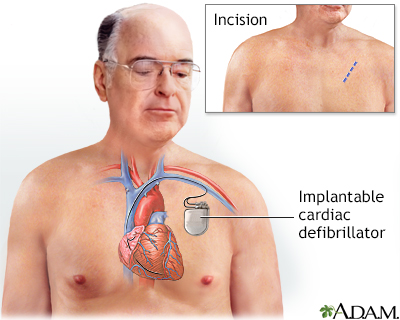Pregnancy SmartSiteTM
Wide-complex tachycardia; V tach; Tachycardia - ventricular DefinitionVentricular tachycardia (VT) is a rapid heartbeat that starts in the lower chambers of the heart (ventricles). CausesVT is a pulse rate of more than 100 beats per minute, with at least 3 abnormal rapid heartbeats in a row. The condition can develop as an early or late complication of a heart attack. It may also occur in people with:
VT can occur without other heart disease. Scar tissue may form in the muscle of the ventricles days, months, or years after a heart attack. This can lead to ventricular tachycardia. VT can also be caused by:
"Torsade de pointes" is a specific form of VT. It is often due to congenital heart disease or the use of certain medicines. SymptomsYou may have symptoms if the heart rate during a VT episode is very fast or lasts longer than a few seconds. Symptoms may include:
Symptoms may start and stop suddenly. In some cases, there are no symptoms. Exams and TestsThe health care provider will look for:
Tests that may be used to detect ventricular tachycardia include:
You may also have blood chemistries and other tests. TreatmentTreatment depends on the symptoms, and the type of heart disorder. If someone with VT is in distress, they may require:
After an episode of VT, steps are taken to prevent further episodes.
 Outlook (Prognosis)The outcome depends on the heart condition and symptoms. Possible ComplicationsVentricular tachycardia may not cause symptoms in some people. However, it can be deadly. It is a major cause of sudden cardiac death. When to Contact a Medical ProfessionalGo to the emergency room or call 911 or the local emergency number if you have a rapid, irregular pulse, faint, or have chest pain. All of these may be signs of ventricular tachycardia. PreventionIn some cases, the disorder cannot be prevented. In other cases, it can be prevented by treating heart problems and avoiding certain medicines. ReferencesAl-Khatib SM, Stevenson WG, Ackerman MJ, et al. 2017 AHA/ACC/HRS Guideline for management of patients with ventricular arrhythmias and the prevention of sudden cardiac death: a report of the American College of Cardiology/American Heart Association Task Force on clinical practice guidelines and the Heart Rhythm Society [published correction appears in J Am Coll Cardiol. 2018;72(14):1760]. J Am Coll Cardiol. 2018;72(14):1677-1749. PMID: 29097294 pubmed.ncbi.nlm.nih.gov/29097294/. Epstein EF, DiMarco JP, Ellenbogen KA, Estes NA 3rd, et al. 2012 ACCF/AHA/HRS focused update incorporated into the ACCF/AHA/HRS 2008 guidelines for device-based therapy of cardiac rhythm abnormalities: a report of the American College of Cardiology Foundation/American Heart Association Task Force on Practice Guidelines and the Heart Rhythm Society. J Am Coll Cardiol. 2013;661(3):e6-75. PMID: 23265327 pubmed.ncbi.nlm.nih.gov/23265327/. Garan H. Ventricular arrhythmias. In: Goldman L, Cooney KA, eds. Goldman-Cecil Medicine. 27th ed. Philadelphia, PA: Elsevier; 2024:chap 53. Stevenson WG, Keppenfeld K. Ventricular Arrhythmias. In: Libby P, Bonow RO, Mann DL, Tomaselli GF, Bhatt DL, Solomon SD, eds. Braunwald's Heart Disease: A Textbook of Cardiovascular Medicine. 12th ed. Philadelphia, PA: Elsevier; 2022:chap 67. | |
| |
Review Date: 5/27/2024 Reviewed By: Michael A. Chen, MD, PhD, Associate Professor of Medicine, Division of Cardiology, Harborview Medical Center, University of Washington Medical School, Seattle, WA. Also reviewed by David C. Dugdale, MD, Medical Director, Brenda Conaway, Editorial Director, and the A.D.A.M. Editorial team. The information provided herein should not be used during any medical emergency or for the diagnosis or treatment of any medical condition. A licensed medical professional should be consulted for diagnosis and treatment of any and all medical conditions. Links to other sites are provided for information only -- they do not constitute endorsements of those other sites. No warranty of any kind, either expressed or implied, is made as to the accuracy, reliability, timeliness, or correctness of any translations made by a third-party service of the information provided herein into any other language. © 1997- A.D.A.M., a business unit of Ebix, Inc. Any duplication or distribution of the information contained herein is strictly prohibited. | |

 Implantable cardio...
Implantable cardio... Implantable cardia...
Implantable cardia...
